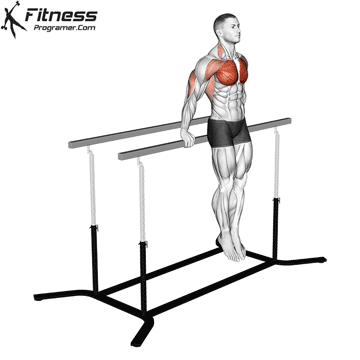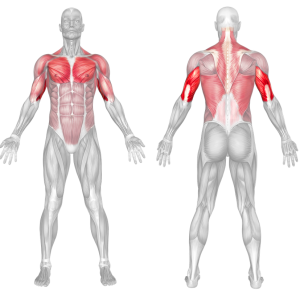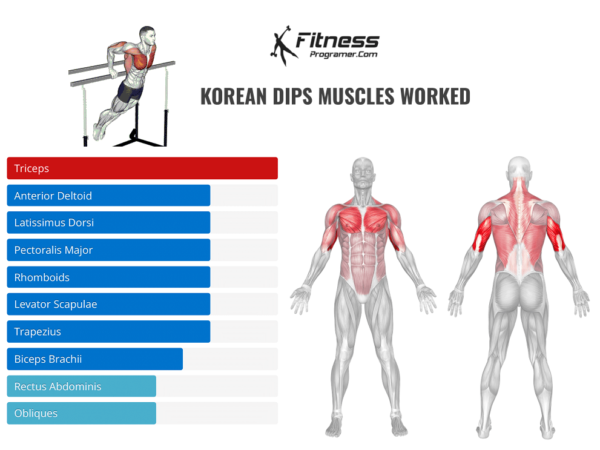Korean Dips Overview
The Korean Dip is a challenging calisthenics exercise that takes your upper body strength to the next level. Unlike standard dips, this variation emphasizes the triceps, chest, shoulders, and core, while also requiring enhanced balance and control. If you’re dedicated to calisthenics workouts, incorporating Korean Dips into your training program is an excellent way to significantly enhance your upper body strength.
How to Perform Korean Dips

Setup & Positioning:
- Find a parallel bar station or dip bars at a comfortable width (slightly wider than shoulder-width).
- Grip the bars with a neutral grip (palms facing inward).
- Lift your legs behind your body, keeping them straight (instead of tucked forward like in traditional dips).
- Keep your core engaged and your body in a slight forward lean.
Execution:
Lowering Phase (Eccentric)
- Slowly lower your body downward, allowing your shoulders to travel slightly behind the bars.
- Keep your elbows tucked close to your torso to avoid excessive strain.
- Lower until your shoulders are level with or slightly below your elbows.
- Feel the stretch in your chest and shoulders at the bottom position.
Pressing Phase (Concentric)
- Push yourself back up explosively, engaging your pecs, triceps, and shoulders.
- Maintain a controlled movement, avoiding swinging or momentum.
- Fully extend your arms at the top while keeping tension in your muscles.
Tips for Proper Form
- Engage your core – Helps stabilize your body and prevents unnecessary swinging.
- Keep elbows slightly tucked – Avoid excessive flaring to protect the shoulders.
- Control the descent – Don’t drop too fast, as this increases injury risk.
- Maintain a neutral spine – Don’t overarch your lower back.
- Lean forward slightly – Helps emphasize the chest and shoulders.
Common Mistakes to Avoid
- Dropping too fast – Increases shoulder strain and risk of injury.
- Excessive elbow flare – Can put unnecessary stress on the joints.
- Not leaning forward – Turns the movement into a triceps-dominant dip instead of engaging the chest.
- Arching the lower back too much – Leads to poor posture and reduced muscle engagement.
- Not fully locking out at the top – Reduces the effectiveness of the movement.
Note: Korean Dips are a tough dip types that will really test your shoulder mobility. The downside of this movement is that it puts a lot of pressure on your shoulders and elbows, so you should never do it unless you are prepared for it.
Training Variables & Modifications
Reps & Sets Recommendations:
- Strength Focus: 4-6 reps x 4-5 sets
- Hypertrophy (Muscle Growth): 8-12 reps x 2-4 sets
- Endurance: 12-15+ reps x 3-4 sets
Progressions & Advanced Variations:
- Weighted Korean Dips – Add a weight belt or hold a dumbbell between your legs.
- Slow Eccentric Korean Dips – Lower for 3-5 seconds to build strength.
- Explosive Korean Dips – Push up fast for power training.
- Ring Korean Dips – Use gymnastics rings for added instability and difficulty.
Regressions for Beginners:
- Assisted Korean Dips – Use resistance bands or an assisted dip machine.
- Standard Dips – Perform regular parallel bar dips first.
- Partial Range Korean Dips – Lower halfway instead of full depth.
Benefits of Korean Dips
Enhanced Upper Body Strength
- Korean dips are highly effective for building explosive strength in the triceps, chest, and shoulders. The unique movement pattern emphasizes controlled, full-range motion, engaging multiple muscle groups simultaneously.
Core Engagement
- The extended leg position inherent in Korean dips forces the core muscles, especially the rectus abdominis and obliques, to work harder to maintain balance and stability throughout the movement. This makes it a great core-strengthening exercise alongside its upper body benefits.
Improved Bodyweight Control
- Performing Korean dips requires significant coordination and balance, which enhances body awareness and control. These attributes are crucial for progressing to advanced calisthenics movements like planches and muscle-ups.
Versatility
- Korean dips can be adapted to various training setups. Use parallel bars, dip bars, or gymnastic rings to adjust the difficulty level. Rings, in particular, add an element of instability, intensifying the core and stabilizer muscle engagement.
Functional Strength
- The movement pattern in Korean dips mimics real-world motions, contributing to improved functional strength. This translates to better performance in daily activities, sports, and other physical tasks requiring upper body power and endurance.
Shoulder Mobility and Stability
- By incorporating an extended range of motion, Korean dips promote shoulder mobility and strengthen stabilizing muscles. This reduces the risk of injuries and supports joint health.
Aesthetic Benefits
- The exercise targets multiple upper body muscles simultaneously, helping to develop a well-defined chest, strong arms, and broad shoulders, contributing to an aesthetically balanced physique.
Korean Dips Muscles Worked


